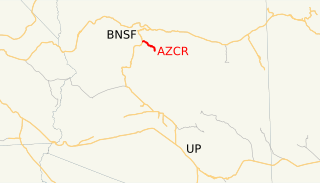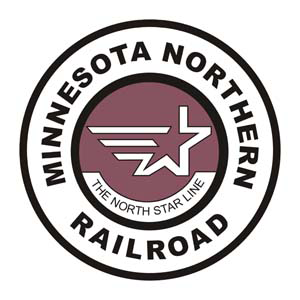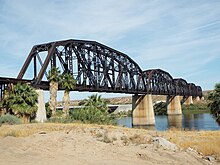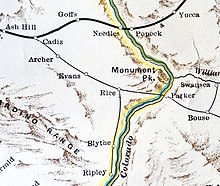
The Verde Canyon Railroad is a heritage railroad running between Clarkdale and Perkinsville in the U.S. state of Arizona. The passenger excursion line operates on 20 miles (32 km) of tracks of the Clarkdale Arizona Central Railroad (AZCR), a shortline. The Verde Canyon Railroad has its depot, headquarters, and a railway museum in Clarkdale, about 25 miles (40 km) southwest of Sedona.

The Portland and Western Railroad is a 516-mile (830 km) Class II railroad serving the U.S. state of Oregon, and is a wholly owned subsidiary of shortline and regional railroad holding company Genesee & Wyoming Inc. The PNWR includes a subsidiary, the Willamette and Pacific Railroad.

The California Northern Railroad is one of several Class III short-line railroad companies owned by Genesee & Wyoming, Inc. It operates over Southern Pacific Railroad (SP) tracks under a long-term lease.

The Pacific Harbor Line was formed in 1998 to take over the Harbor Belt Line (HBL). In 1998, the Alameda Corridor was nearing completion, allowing for a massive amount of railroad traffic from the largest harbors in the Western hemisphere: Port of Los Angeles and Port of Long Beach.

The Modesto and Empire Traction Company is a Class III short-line railroad operating in California's San Joaquin Valley. It is owned by the Beard Land & Investment Company; the Beard family has always owned the railroad. The Beards also created the Beard Industrial Park where the MET's customers are located. The railroad was unique in that it had operated for nearly 50 years exclusively with GE 70-ton switchers built between 1947 and 1955; however, a former Southern Pacific EMD SW1500 switcher was added to the roster as of late. The MET operates on 5 miles (8 km) of mainline track, as well as an additional 48.7 miles (78.4 km) of yard and industry track, providing switching services in the Beard Industrial Park. The MET interchanges with the Union Pacific at Modesto and with the BNSF Railway Stockton Subdivision at Empire.

The Willamette Valley Railway is a short-line railroad that operates in the Willamette Valley of Oregon. It leased a line from Woodburn to Stayton from the Southern Pacific Transportation Company in February 1993, as well as a branch from Geer west to Salem, and purchased the property in 1996. The company also leased a line between Albany and Mill City in 1993, but transferred the lease to the Albany and Eastern Railroad in October 2000.
The Santa Maria Valley Railroad is a 14.8 miles (23.8 km) shortline railroad that interchanges with the Union Pacific Railroad's Coast Line at Guadalupe, California. As of 2006, the Railroad is owned by the Coast Belle Rail Corporation.

The Arizona Eastern Railway is a Class III railroad that operates 206 miles (332 km) of railroad between Clifton, Arizona, and Miami, Arizona, in the United States. This includes trackage rights over the Union Pacific Railroad between Lordsburg, New Mexico, and Bowie, Arizona. The railroad serves the copper mining region of southeastern Arizona, and the agricultural Gila River Valley. The railroad offers a transload location for lumber, building materials and other consumer commodities at Globe, Arizona. As of 2023, AZER has a maximum capacity of 286,000, and has one interchange: Union Pacific.

The Apache Railway is an Arizona short-line railroad that operates from a connection with the BNSF Railway at Holbrook to the Snowflake Mill near Snowflake, Arizona, 38 miles (61 km). The APA was acquired by Catalyst Paper from Abitibi Consolidated in 2008. The Snowflake paper mill shut down permanently on September 30, 2012. In late 2015, the railway was purchased out of bankruptcy by a group including Aztec Land & Cattle Company and Midwest Poultry Producers, L.P., thereby avoiding a shutdown and scrappage of the line. The railway continues to operate, and its revenues are driven primarily by car repair and storage. The railway's freight revenues have not yet recovered from the shutdown of the Snowflake paper mill then owned by Catalyst, although efforts to enhance them continue.

The Clarkdale Arizona Central Railroad is an Arizona short-line railroad that operates from a connection with the BNSF Railway at Drake, Arizona. The AZCR runs 37.8 miles (60.8 km) from Drake to Clarkdale, Arizona. An excursion train also runs on the line through Verde Canyon and is operated by the same owners under the Verde Canyon Railroad. The AZCR is owned by David L. Durbano.

The Santa Fe, Prescott and Phoenix Railway (SFP&P) was a common carrier railroad that later became an operating subsidiary of the Atchison, Topeka and Santa Fe Railway in Arizona. At Ash Fork, Arizona, the SFP&P connected with Santa Fe's operating subsidiary, the Atlantic & Pacific Railroad mainline, that ran from California to Chicago. The SFP&P's 195-mile (314 km) line extended the Santa Fe Railway south into Phoenix. The SFP&P extended another 100 miles (160 km) to the east from Phoenix to Florence and Winkelman via the Phoenix and Eastern Railroad. The SFP&P also served several mines in the Prescott area, including the Derby Mine by way of the Summit (flag) Station at 'Prieta' in the Sierra Prieta range, through its various subsidiary railroads.

The Minnesota Northern Railroad is a Class III shortline railroad that operates over 224 miles (360 km) of track in northwestern Minnesota. The railroad is co-owned by KBN Incorporated and Independent Locomotive Service and is headquartered in Crookston, Minnesota.
The BG&CM Railroad or Bountiful Grain and Craig Mountain Railroad is a Class III shortline railroad located in North Central Idaho.

The Puget Sound and Pacific Railroad operates over 150 miles of track serving the U.S. State of Washington, and is headquartered in Centralia, Washington where interchanges with the BNSF Railway and Union Pacific Railroad are made.

The West Texas & Lubbock Railway is a shortline railroad in Texas, owned by Watco. It connects the BNSF in Lubbock with agricultural and oil-producing areas to the west and southwest. The company operates 107 miles of two ex-Atchison, Topeka & Santa Fe Railway lines, extending to Whiteface and Seagraves parallel to State Highway 114 and U.S. Highway 62. The primary commodities hauled are fertilizer, construction aggregates, grain, cotton, chemicals, peanuts and plastics.
The Manufacturers' Junction Railway is a shortline railroad in Cicero, Illinois. Originally a subsidiary of Western Electric used to switch their Hawthorne Works, after the plants were phased out it was sold to OmniTRAX, a company offering railroad management and other services.
The Grand Forks Railway is a shortline railway company operating in the West Kootenay region of southeastern British Columbia.

The Ripley & New Albany Railroad is a 27-mile long (43 km) shortline railroad that runs from New Albany to Falkner, Mississippi, and previously extended from Houston, Mississippi, to Middleton, Tennessee, along former Gulf, Mobile and Ohio Railroad trackage. RNA interchanges with the BNSF Railway in New Albany, Mississippi. It primarily hauls lumber products and Oil-Dri.
Barstow Yard is a classification yard operated by Burlington Northern Santa Fe Railway (BNSF) in Barstow, California. With 48 directional tracks and a total area of approximately 600 acres (240 ha), it is the second largest classification yard west of the Rocky Mountains after the JR Davis Yard. Today, almost all freight traffic to and from Southern California runs through the junction.


















